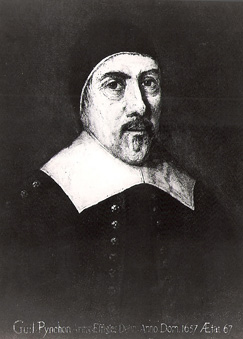colonial period
William Pynchon
In April 1630, William Pynchon sailed from Southampton, England for North America as one of the founders of the Massachusetts Bay Colony. Pynchon began trading furs along the Atlantic coast, but the enterprise failed. In the autumn of 1635, Pynchon sailed up the Connecticut River investigating prospects for the lucrative beaver trade. He returned in the spring of 1636 and purchased 150 acres of land from the indigenous Agawams, who lived along the western shore. On a large island in the river, Pynchon established Agawam Plantation as a fur trading outpost. He chose the site for its proximity to the indigenous groups from whom he could acquire beaver pelts, and for the natural defense against attack provided by the river.
Pynchon envisioned the settlement as a self-sufficient industrial community, with agriculture necessary only for sustenance. The whole enterprise was initially based on the fur trade, and when the settlement expanded onto the less-fertile eastern shore of the river all but a few of the original settlers abandoned the village. Pynchon used land grants and indentured servants to populate the village, favoring admittance for those who could provide something of value to the community. He recruited artisans and tradesmen from other towns — carpenters, brick masons, smiths and coopers, weavers and tailors — to make the settlement independent of outside sources of supply. In tribute to Pynchon's efforts on behalf of the village, settlers renamed it Springfield after his hometown in England. Pynchon served as the Justice of the Peace and held court in his home. A board of selectmen governed the settlement.
Pynchon remained the sole furrier in the area, and reaped the benefits of an international trade in pelts that began in Western Massachusetts, passed through Boston and went finally to London. Pynchon relied on an Indian interpreter and assistant in business dealings with other native groups. Not all of Pynchon's business dealings were successful, however. In the late 1630s, Connecticut settlers suffered a corn shortage as a consequence of the Pequot War. Buying corn from the local indigenous groups, Pynchon sold it at a high profit to Hartford area settlers. He was found guilty of speculation by the Connecticut General Court. He also refused to help Connecticut fight the Pequots. Hartford, a competitor in the fur trade and rarely friendly, became now even more hostile towards the Springfield settlement.
Pynchon would also find himself in trouble over his religious beliefs. He was accused of heresy in 1650 over his book, The Meritorious Price of Our Redemption , which refuted Puritan theology by claiming that obedience, rather than punishment and suffering, was the price of atonement. The General Court of Massachusetts Bay denounced the book and ordered it burned at the market place in Boston. Pynchon's tract was thrown to the flames, and only a few copies remain today. One is on display at the Museum of Springfield History, in Springfield, MA.
Pynchon's troubles with the religious authorities coincided with an outbreak of witchcraft hysteria in Springfield during which several people were condemned to death. Perhaps sensing his position a little too precarious under the circumstances, Pynchon decided to return to England in 1652 and turned his holdings over to his son John.